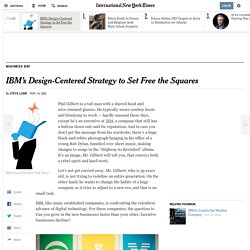

Design Thinking. 什麼是設計思考?(What is Design Thinking) What Is Design Thinking? The Design Process: From Idea to Solution. Generating Ideas. In this lesson, students will learn to consciously engage in the idea generation process.

Time Allotment 40-60 minutes Learning Objectives Students will learn to systematically generate ideas for innovation using two distinct approaches. Prep for Teachers Arrange desks or tables in the classroom so students can form groups. (Optional) Before you begin the lesson, generate a list of leading questions that you will use to help students in the event that they have trouble generating ideas. Instruct the students to form groups and sit with their group mates. Supplies Inspirational materials. Picture booksMagazinesFound objectsVisual art pieces Other materials: Post-it notes (regular size)PencilsErasers Introductory Activity Video Watch the video entitled Generating Ideas. Learning Activities Method #1: Quantity Over Quality. Untitled Drip for SumoMe Onboarding Campaign. I recently finished the book Creativity, Inc.

I'm hoping to start a monthly book club soon and I have a hunch this might be the first book on the list. Written by Ed Catmull, the president of Pixar Animation and Disney Animation, the book explores the topics of innovation, creativity, and leadership by offering a behind-the-scenes view of the Pixar story. I am naturally skeptical when people point to corporations as examples that schools should emulate. We are not making a product and we should not be governed by economic norms. Fifty Recommended Books on Creativity – John Spencer. Ten Things That Happen When Kids Engage in Design Thinking – John Spencer. Creativity and innovation have become buzzwords in education (though not as quite as trendy as hipster beards or skinny jeans).
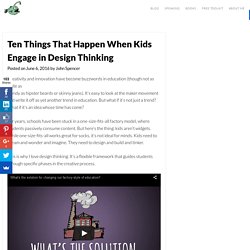
It’s easy to look at the maker movement and write it off as yet another trend in education. Welcome to the Virtual Crash Course in Design Thinking. Welcome to the d.school’s Virtual Crash Course resource page!
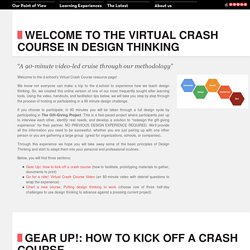
We know not everyone can make a trip to the d.school to experience how we teach design thinking. So, we created this online version of one of our most frequently sought after learning tools. Using the video, handouts, and facilitation tips below, we will take you step by step through the process of hosting or participating in a 90 minute design challenge. If you choose to participate, in 90 minutes you will be taken through a full design cycle by participating in The Gift-Giving Project.
This is a fast-paced project where participants pair up to interview each other, identify real needs, and develop a solution to “redesign the gift-giving experience” for their partner.
Jonathan Bendor: A Toolkit for Solving Problems. In the middle of the 20th century, the standard recommendation regarding problem solving went something like this: Create an extensive strategic plan with a few rigidly outlined logical steps.
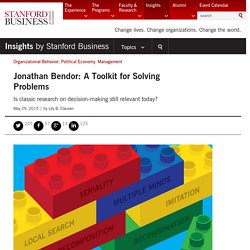
The synoptic method, as this conventional procedure was known, amounted to a prescription that didn’t actually work well for hard problems. Indeed, when faced with really complex decisions, organizational behavior theorist Charles Lindblom argued the problem solver was actually better off “muddling through.” Lindblom’s crucial move in his 1959 essay “The Science of Muddling Through” and partner papers was to challenge the conventional prescription to problem solving.
He introduced the idea of disjointed incrementalism, a package of heuristics that could be used to make small, incremental changes along the way. Disjointed incrementalism rang true for several generations of scholars and problem solvers. What he found was mixed. Consider Duplo blocks, the little sibling to Lego building blocks. An Introduction to Design Thinking (Part Two) In the constructivist-learning model, engagement and experience combine with immersive environments and self-organisation of knowledge to establish a context in which learning occurs naturally.
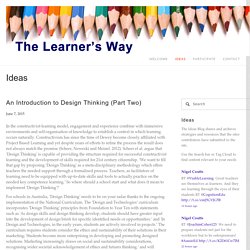
Constructivism has since the time of Dewey become closely affiliated with Project Based Learning and yet despite years of efforts to refine the process the result does not always match the promise (Scheer, Noweski and Meinel. 2012). Scheer et al. argue that ‘Design Thinking’ is capable of providing the structure required for successful constructivist learning and the development of skills required for 21st century citizenship.
Design Thinking. Stefanos Zenios: Design Thinking is About Doing. Design Thinking - An Intro. Design Thinking with SAP - Imagine. Create. Innovate. Design Thinking Teacher Training Video // Part 2 of 2. Design Thinking Teacher Training Video // Part 1 of 2. What is Design Thinking? Design Thinking. What is Design Thinking (2015) Paper Mechatronics. Papercraft invites a diverse range of people, notably children, to investigate art, craft and mechanics through hands-on making.
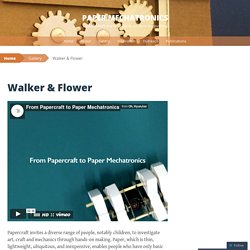
Paper, which is thin, lightweight, ubiquitous, and inexpensive, enables people who have only basic technical skills to work in this playful creative and educational medium. Today, the design space of papercraft can be enlarged with recent high-low technology innovations: electronics and computing components can add autonomous movement and interaction to papercraft objects.
We call this interdisciplinary domain “Paper Mechatronics”—the combination of mechanisms, electronics, and computation with the traditional cutting and folding activities of papercraft. The Marshall Memo Admin - Issues. 1.

Four human biases that prevent organizations from succeeding 2. IBM’s Design-Centered Strategy to Set Free the Squares. Photo Phil Gilbert is a tall man with a shaved head and wire-rimmed glasses.
